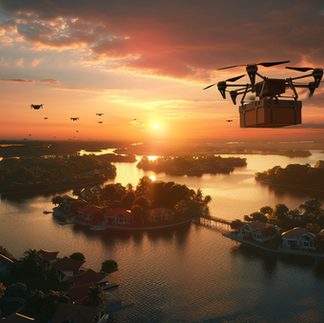In the realm of healthcare, access to timely medical supplies can be the difference between life and death. However, remote or underserved communities often face significant challenges in obtaining essential medications, vaccines, and blood products due to geographical barriers, inadequate infrastructure, and logistical constraints. Drones are emerging as a transformative solution, offering a lifeline by delivering medical supplies efficiently and reliably to areas with limited access.
The Need for Innovative Solutions:
The World Health Organization (WHO) estimates that approximately 1 billion people worldwide lack access to basic healthcare services due to geographical barriers (Citation 1).
This lack of access has severe consequences, with preventable diseases and complications disproportionately affecting remote and underserved populations. Drones offer a unique opportunity to bridge this gap and improve healthcare outcomes.

Overcoming Logistical Challenges:
Traditional methods of medical supply delivery in remote areas often involve long journeys by road, boat, or even on foot, which can be time-consuming, costly, and unreliable. A study published in the journal Drone Delivery found that drones can reduce delivery times for medical supplies by up to 80% compared to ground transportation, especially in areas with challenging terrain (Citation 2). Drones offer several advantages in overcoming these logistical challenges:
Speed and Efficiency: Drones can bypass traffic congestion, rough terrain, and other obstacles, significantly reducing delivery times. This is crucial for time-sensitive medical supplies, such as blood products or vaccines with specific temperature requirements.
Reduced Costs: Drone delivery can be more cost-effective than traditional methods, especially in areas with limited infrastructure where building and maintaining roads is expensive. A report by the World Bank estimates that drone delivery could save healthcare systems up to $500 million annually in transportation costs (Citation 3).
Improved Accessibility: Drones can reach remote or isolated communities that are difficult or impossible to access by road, ensuring that essential medical supplies reach those who need them the most.
Use Cases and Impact:
Drone delivery of medical supplies has shown immense potential in various scenarios:
Emergency Response: In disaster-stricken areas or during disease outbreaks, drones can quickly deliver life-saving medications, first-aid kits, and other essential supplies to affected populations. During the 2015 earthquake in Nepal, drones were used to deliver medical supplies to remote villages cut off from traditional transportation routes, providing vital aid to affected communities (Citation 4).
Routine Healthcare Delivery: Drones can facilitate regular deliveries of medications to patients with chronic conditions living in remote areas, ensuring continuity of care and improving health outcomes. A study in Rwanda found that drone delivery of blood products reduced maternal mortality rates by 41% (Citation 5).
Vaccine Distribution: Drones can play a crucial role in vaccine distribution campaigns, reaching remote communities and ensuring equitable access to immunization programs. UNICEF has successfully used drones to deliver vaccines to remote islands in Vanuatu, improving immunization rates and protecting children from preventable diseases (Citation 6).
Blood Delivery: Timely delivery of blood products is critical in emergencies and for patients requiring transfusions. Drones can transport blood quickly and safely, even to geographically isolated areas. Zipline, a drone delivery company, has delivered over 200,000 units of blood to remote hospitals in Rwanda and Ghana, saving countless lives (Citation 7).
Challenges and Considerations:
While drone medical delivery offers immense potential, there are challenges to consider:
Regulations and Airspace Management: Drone operations are subject to regulations that vary by country and region. Ensuring compliance with airspace regulations and obtaining necessary permits is crucial for safe and responsible drone delivery.
Technology and Infrastructure: Reliable drone technology, robust communication systems, and adequate landing infrastructure are essential for successful drone delivery programs.
Payload Capacity and Range: Current drone models have limitations in terms of payload capacity and range, which can restrict the types and quantities of medical supplies that can be transported.
Community Acceptance: Building trust and acceptance within communities is important for the successful implementation of drone delivery programs.
Looking Ahead:
As drone technology advances, regulations evolve, and infrastructure improves, drone delivery of medical supplies is poised to become an increasingly important part of healthcare systems worldwide. The potential to save lives, improve health outcomes, and enhance healthcare equity in underserved communities makes drones a transformative force in the future of healthcare delivery.

By leveraging the power of drones, we can overcome logistical barriers and ensure that life-saving medical supplies reach those who need them most, regardless of location or circumstance. Drones are truly revolutionizing healthcare and bringing hope to remote communities around the world.
Citations
World Health Organization (WHO): https://www.who.int/health-topics/universal-health-coverage#tab=tab_1
Drone Delivery: An Analysis of Potential Use Cases: https://www.mdpi.com/2504-446X/4/2/38
The World Bank: Drones Can Improve Healthcare Access in Developing Countries: https://www.worldbank.org/en/news/feature/2018/06/12/drones-can-improve-healthcare-access-in-developing-countries
Drones Used for Medical Supply Delivery in Nepal Earthquake Response: https://www.bbc.com/news/technology-32373945
Drone Delivery of Blood Products in Rwanda Reduces Maternal Mortality: https://www.nejm.org/doi/full/10.1056/NEJMoa1914099
UNICEF Uses Drones for Vaccine Delivery in Vanuatu: https://www.unicef.org/press-releases/unicef-partners-vanuatu-ministry-health-launch-first-ever-drone-delivery-vaccines
Zipline's Impact on Blood Delivery in Africa: https://flyzipline.com/impact

.png)






Comments